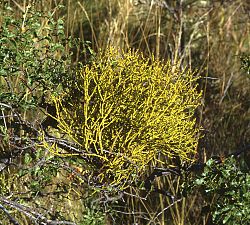| Santalales | |
|---|---|
 | |
| Santalum haleakalae | |
| Scientific classification | |
| Kingdom: | Plantae |
| Clade: | Tracheophytes |
| Clade: | Angiosperms |
| Clade: | Eudicots |
| Clade: | Superasterids |
| Order: | Santalales R.Br. ex Bercht. & J.Presl [1] |
| Families | |
See text | |
| Synonyms | |
Balanophorales | |
The Santalales are an order of flowering plants of eudicots. Well-known members of the Santalales include sandalwoods and the many species of mistletoes. The order has a cosmopolitan distribution, but is heavily concentrated in tropical and subtropical regions. It derives its name from its type genus, Santalum (sandalwood).







